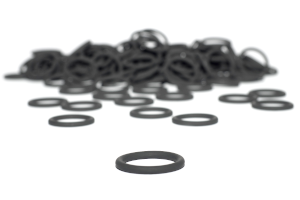HNBR O-RINGS | MATERIALS SIMPLY EXPLAINED
What are HNBR O-rings?
HNBR (hydrogenated acrylonitrile butadiene rubber) is one of the elastomers with the widest range of applications in industry.
Not only sealing rings, but also timing belts and hydraulic hoses are made from this material.
This already shows the potential of HNBR for use as an O-ring: The combination of good mechanical strength and a high maximum operating temperature characterizes HNBR sealing elements.
It is also resistant to mineral oil-based media. HNBR is produced by partially or fully hydrogenating the O-ring material NBR (acrylonitrile butadiene rubber).
This step enables key improvements in the properties of HNBR compared to NBR, above all resistance to weathering and ozone as well as higher temperature resistance.
Many heavily loaded NBR O-rings are increasingly being replaced by variants made of the higher-performance but also more cost-intensive HNBR. Practitioners also know HNBR under the trade names Therban® or Zetpol®.

Feature | Value |
|---|---|
ISO designation | HNBR |
Trade names | Therban, Zetpol |
Chemical name | Hydrogenated nitrile butadiene rubber |
Media resistance | Good media resistance |
Temperature resistance | -30°C to +150°C |
Standard color | Black |
Standard hardness | 70 Shore A |
Industries | Oil&Gas, Automotive industry |
Production | Compression molding and injection molding |
Tolerances | DIN ISO 3601 |
Durability | 8 years |
REQUEST HNBR O-RINGS QUICKLY AND EASILY?
Almost any dimension available
Over 10,000 FKM dimensions available from stock
Offer received in record time
No minimum order values or minimum quantities
#1 The 5 most important advantages of HNBR O-rings
1. high resistance to oil and grease based on mineral oil
2. low gas permeability to gas and vapor
3. good mechanical properties
4. wide temperature range
5. suitable for dynamic applications
The fact that HNBR is also used as a material for timing belts in the automotive industry makes it clear: O-rings made from this material are suitable for use in dynamic seals.
When O-rings seal components that are in motion against each other, they are subject to particular stress. Friction occurs under these conditions, which can cause material loss on the O-ring.
Added to this is the increased temperature input into the material, which can lead to a change in the internal structures. Due to their properties, HNBR O-rings can withstand both loads and can be used for dynamic applications with sufficient durability.
The wide temperature range, coupled with resistance to mineral oil-based products, makes HNBR O-rings suitable for seals in automotive drives.
In combustion engine components, the O-rings come into contact with hot media such as cooling water, fuels, air or oil, which can also occur as a mixture.
In addition to these mass applications, HNBR O-rings also qualify for special industries such as gas exploration. This is due to the material’s particularly low permeability to gas and vapor.
A comparison of the most important O-ring materials
Material | Temperature resistance | Chemical resistance | Elasticity |
|---|---|---|---|
NBR | -30°C to +120°C | Low | High |
HNBR | -30°C to +150°C | Medium | High |
EPDM | -45°C to +150°C | Medium | High |
SILICONE | -60°C to +200°C | Low | High |
FKM (VITON) | -25°C to +200°C | Medium | High |
FEP coated | -60°C to +200°C | High | Medium |
PTFE | -250°C to +250°C | High | Low |
FFKM | -40°C to +340°C | High | High |
#2 The 3 most common areas of application for HNBR O-rings
Automotive industry
In automotive combustion engines, engine oils according to the SAE classification are used to lubricate moving parts.
HNBR O-rings are resistant to these media in a temperature range from -30 degrees to 150 degrees. This means that the O-rings cover the full application-specific temperature spectrum.
Thanks to their stable elastic properties and freedom from fatigue, they ensure a permanent sealing of the motor components against each other and against the environment. This also applies after long periods of standing in extreme cold or under the high temperatures of continuous operation.
Drinking water systems
Facilities for the storage, treatment and distribution of drinking water are subject to intensive controls because they are critical for human and animal health.
The components in such drinking water systems must therefore meet numerous requirements. Many mostly national regulations ensure the safety of the components, including the sealing elements.
O-rings made of HNBR pass these special physical and microbiological tests, making them suitable for the safe operation of drinking water systems. The KTW guideline is the leading guideline for Germany.
Corresponding qualities of HNBR O-rings are available as standard. They are also available in FDA-compliant versions and with approvals in accordance with numerous other national guidelines such as KIWA for the Netherlands or WRAS for the UK.
GAS supply and gas consumption
HNBR has both key properties for use with gas:
The good chemical resistance together with the low gas permeability make HNBR O-rings a valuable option for sealing gas-carrying systems.
The specific requirements for this area of application are set out in the guidelines DIN EN 549, VP 406 and VP 614.
#3 What is the media resistance of HNBR O-rings?
In addition to the increased temperature range, HNBR is also superior to the base material NBR due to its improved resistance to oxidative attack. This is an important addition to the already broad durability profile for practical use.
HNBR is resistant to:
– Aliphatic hydrocarbons
– Animal and vegetable fats and oils
– Water and water vapor within the upper continuous temperature of 150 degrees
– Flame retardant pressure fluids: HFA, HFB, HFC fluids
– Light heating oil and diesel fuel
– Acids, bases and salt solutions diluted at low temperature
– Ozone and weather
HNBR swells strongly in aromatic hydrocarbons such as benzene or trichloroethylene.
This swelling causes a significant reduction in the mechanical properties of HNBR O-rings. However, these return after the material has dried again. The resistance of HNBR O-rings to oil depends largely on the acrylonitrile (ACN) content of the material compound.
A higher proportion of the mixture increases the insensitivity, but at the same time causes a deterioration in the low-temperature behavior. The right HNBR material should therefore be selected depending on the specific application.
This allows the maximum performance of HNBR O-rings to be utilized.
#4 What is the temperature resistance of HNBR O-rings?
HNBR O-rings have a temperature resistance of -30°C to +150°C.
The temperature range of common grades of HNBR O-rings extends from -30 to +150 degrees.
Depending on its composition, HNBR is also suitable for low temperatures down to -40 degrees. This means that HNBR covers similarly low temperatures as the alternative sealing materials NBR, FKM or FFKM.
In terms of maximum continuous temperature, HNBR is comparable to ACM or EPDM. The market offers FKM or VMQ but also materials with a significantly higher upper temperature limit.
Thermally aged HNBR O-rings show significantly less swelling in contact with the media. The loss of mechanical properties is also less pronounced.
This is due to a higher cross-linking density compared to the starting material. In general, the temperature and media resistance of O-ring materials must always be evaluated in context.
For example, the temperature ranges of HNBR O-rings in contact with certain media can deviate significantly from the general specifications. The choice of material must therefore always be based on the specific application.
#5 What are the mechanical properties of HNBR O-rings?
1. Excellent abrasion resistance Abrasion
2. High tensile strength
3. Resistant to explosive decompression
HNBR O-rings stand out from the multitude of O-ring materials primarily due to their excellent abrasion resistance.
Together with the temperature suitability, this makes HNBR O-rings insensitive to friction in dynamic seals.
The high tensile strength of the material also contributes to its suitability for this application. Other materials with good abrasion resistance are EPDM, NBR, CR and FKM.
Due to its high mechanical strength, HNBR is also particularly resistant to explosive decompression. This phenomenon occurs when there is a rapid drop in pressure in a gas-bearing sealing system. In response, the gas in the O-ring expands considerably.
If the natural gas permeability of the O-ring material is not sufficient for this, the gas makes its own way through the structure of the material. This results in permanent damage to the O-ring, which manifests itself in cracks and blistering.
The low gas permeability and insensitivity to explosive decompression play an important role, especially for long-term use in the oil and gas industry. The industry has therefore developed its own standard in the form of NORSOK M-710.
As with FFKM and FKM, compliant HNBR O-rings are also available.
#6 What do I have to consider when designing the groove of an HNBR O-ring?
Groove design of HNBR O-rings
- Compression in the groove should be approx. 20% for static use
- Select lower compression for dynamic sealing
- 20% of the groove should still be free after grouting
- Always design grooves according to the standard tables available on the market
- Permanent elongation after installation should be less than 6%
- Permanent compression after installation should be less than 6%
- Clean the groove space thoroughly before installation
- Do not expand elastic O-rings by more than 50% during installation
- Provide insertion slopes between 15 and 20 degrees
- Deburr drill holes, even if they are only passed over during assembly
- Round off sharp edges with a minimum radius of 0.1 to 0.3 mm
- Use silicone grease to make assembly easier
- Avoid twisting the O-ring
#7 Further important information on HNBR O-rings
Finally, we would like to answer a few questions that we are frequently asked in everyday life.
#7.1 What is an HNBR gasket?
Seals such as O-rings made of HNBR are basically comparable to the widely used material NBR.
However, O-rings made of HNBR (hydrogenated NBR) are more resistant to high temperatures and aggressive media. In addition, HNBR O-rings can be used even better for dynamic applications compared to NBR O-rings.
#7.2 Is there a data sheet for the HNBR O-rings?
You can easily view the data sheet for our HNBR O-rings directly on our website and download it if you wish.
#7.3 What about the HNBR resistance?
HNBR is particularly resistant to aliphatic hydrocarbons and fats and oils.
This makes HNBR the perfect material for the automotive industry and gas and water systems.
#7.4 What is the difference between HNBR vs NBR?
HNBR is very similar to NBR. The “H” in HNBR indicates that the NBR has been hydrogenated. In other words, HNBR is an NBR that has been saturated with additional hydrogen atoms.
This results in the following 3 parts:
1. temperature resistance up to +150°C
2. higher media resistance
3. higher abrasion resistance
“I am convinced that we should share our knowledge with the world. I hope I have been able to answer all your questions. If you have any further questions, please feel free to contact us at any time. We will be happy to help you.”

Lord of the O-rings
Author of the sealing academy



